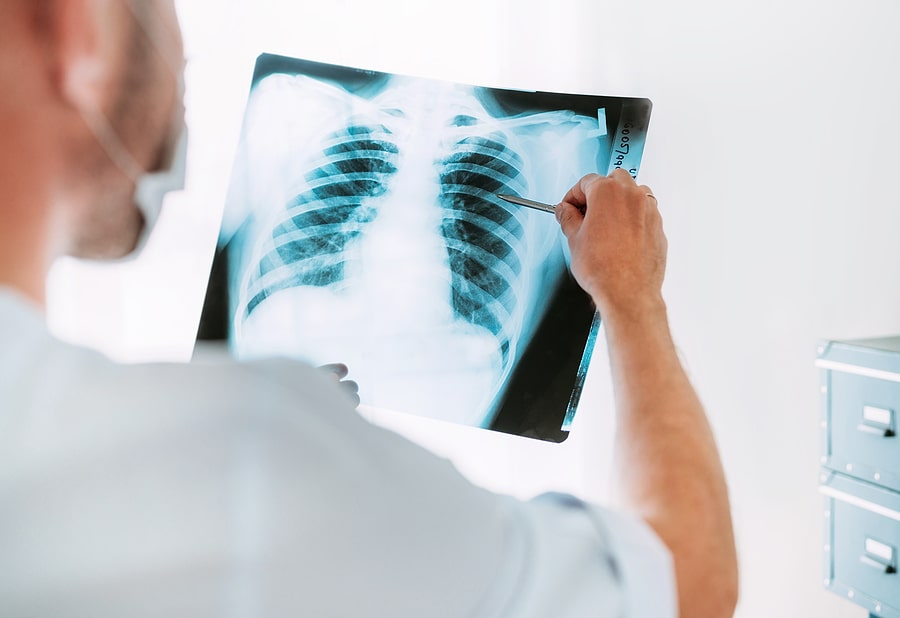
After car crashes, vehicle occupants often suffer from whiplash, slipped discs, and associated muscle strains. However, drivers and front-seat passengers may develop pain, bruising, and swelling around the upper chest area in the days following the collision. Some claimants mistakenly believe they’re only suffering from accident-related anxiety or stress, but these symptoms generally indicate chest contusions.
Many major chest cavity injuries occur during car accidents, but claimants suffering from serious chest swelling, pain, discoloration, and difficulty breathing following motor vehicle collisions may have serious internal bleeding or organ damage.
Understanding Chest Contusions and Related Injuries
Chest contusions, such as chest bruising, occur when a sudden force impacts the chest area. Bruising often occurs when the direct blow breaks the small blood vessels under the skin’s surface by force, but does not break the skin itself. Sudden blood flow under the skin results in black and blue discoloration that disappears as the body heals and naturally reabsorbs the blood. Minor chest contusions do not typically require extensive medical care. Most patients only need over-the-counter medication and ice to reduce swelling.
Due to the inherent force associated with car accidents, chest bruising often accompanies more serious injuries.
Vehicle occupants suffering from intense pain, intense swelling, widespread discoloration, or trouble breathing might have one of the following more serious conditions:
- Pulmonary contusions (bruised lungs) – The greater the crash’s force, the more likely vehicle occupants will suffer from severe blood vessel damage. Prolonged internal bleeding in the chest area often puts pressure on the lungs, damaging additional blood vessels and causing fluid buildup. The crash force might also bruise the lungs directly, leading to life-threatening pulmonary contusions. A bruised lung may result in serious lung infections and respiratory illnesses. These injuries often occur after car accidents, and vehicle occupants suffering from chest bruising should get checked for lung damage.
- Lung tears and pneumothorax (collapsed lung) – Chest contusions frequently accompany collapsed lungs, which occur when a sudden force tears open part of the lung causing air to leak out. This tear depressurizes the lung, leading to collapse. Patients with pneumothorax generally experience shortness of breath, pain, and oxygen deprivation, necessitating immediate medical intervention. Oxygen loss may cause hypoxic brain injuries resulting in cognitive disabilities, heart attacks, and even death.
- Fractured ribs – The rib cage protects the body’s most important organs, and fractured ribs often accompany chest bruising. Minor rib fractures typically heal naturally, although they frequently result in short-term disabilities. Extensive fractures and crushing injuries may puncture the lung or impact vital organ function necessitating surgical intervention
- Organ damage – Car accident chest trauma might also directly damage vital chest-area organs, including the lungs, trachea, diaphragm, esophagus, and heart. Even minor damage to these important respiratory and cardiac systems may lead to long-term disabilities or death.
- Hemothorax– This serious chest condition often presents as a chest contusion following car accidents. Hemothorax occurs when blood begins building in the chest cavity between the chest wall and lungs. Patients often require a drainage tube or surgery to treat this condition and avoid lung and heart damage.
Chest bruising accompanies nearly all of these conditions following a car crash. Seek medical treatment (including X-rays, CT scans, and ultrasounds) after an accident if you experience any swelling, pain, difficulty breathing, bruising, or heart palpitations.
Common Causes of Chest Bruising During Car Crashes
The majority of chest injuries, such as lung contusions and fractured ribs, have motor vehicle-related causes.
Vehicle occupants, cyclists, and pedestrians sustain chest contusions following a collision in five primary ways.
Seatbelt Pressure
Seatbelts save lives but also commonly cause chest bruising. Car crashes often propel vehicle occupants forward, triggering seat belt locking mechanisms designed to stop the wearer from being thrown into the windshield. Seatbelts primarily stop forward momentum by putting pressure across the chest area. This sudden pressure typically results in minor chest contusions.
While claimants may recover compensation for seat belt injuries, minor bruising generally heals after a few weeks. However, high-speed crashes frequently result in vehicle occupants catching their seatbelts with greater force. In such cases, the wearer’s body absorbs most of this impact as seatbelts do not usually snap. Serious accidents may result in fractured ribs or hemothorax from sudden seatbelt lockage.
Steering Wheel and Dashboard Impacts
By virtue of their height or vehicle design, certain occupants sit too close to their steering wheels or dashboards. Seatbelts and airbags may not stop these occupants’ chest areas from hitting these hard surfaces. Steering wheel impacts often result in chest crushing injuries affecting occupants’ hearts, lungs, and ribs. Sudden internal bleeding and pneumothorax may result in rapid oxygen loss, cardiac arrest, and fatalities.
Airbag Deployment
Like seatbelts, airbags save lives. However, airbags only deploy in moderate to severe crashes due to the prevalence of airbag-related injuries. Airbags must deploy with an explosion quick enough to prevent front-seat occupants from striking the vehicle’s hard surfaces. This explosion requires immense energy that often transfers to the occupant.
The NHTSA recommends keeping at least 10 inches between your chest and the airbag deployment surface, typically the center of the steering wheel, to avoid potentially deadly chest injuries.
Propelling into Handlebars
Chest injuries often happen when motor vehicles rear-end cyclists and motorcyclists, propelling riders into the apparatuses’ handlebars. These metallic and often sharp handlebars may cause rib fractures and serious puncture wounds. Claimants often suffer from chest bruising, hemothorax, lung tears, and fractured ribs following high-speed handlebar collisions.
Primary and Secondary Direct Pedestrian Impacts
Many vehicles, especially family SUVs, are chest height. This design means pedestrians struck by motor vehicles in crosswalks often suffer from direct chest-impact injuries. The force of the impact may immediately result in crushed ribs, collapsed lungs, internal bleeding, and cardiac arrest.
Many pedestrians suffer from fatal chest trauma immediately following the impact. Pedestrians might also sustain chest contusions and damage after a secondary impact, typically when the vehicle pushes the pedestrian into a wall or onto a cement surface. Drivers often panic after striking pedestrians and might even run over or strike the injured claimant again in their distress.
The speed and weight of the vehicles involved in the crash, including the angle of impact and passenger placement, contribute to the severity of chest injuries. Generally, the greater the impact speed and impacting vehicle weight, the more likely occupants will suffer from life-altering chest trauma.
Ways to Recover Compensation for Chest Injuries Sustained in Motor Vehicle Collisions
Multiple factors often contribute to car accidents resulting in chest contusions. Rear-end crashes often trigger seatbelt lockage or airbag deployment. They might also reveal dangerous defects in airbags, seatbelts, or vehicle design, contributing to more serious chest injuries.
Claimants might demand financial compensation from multiple parties in such cases, including the careless driver and the vehicle manufacturer. Personal injury attorneys frequently help injured claimants and their families recover damages from different sources.
Private No-Fault and Personal Injury Insurance
Several states require vehicle owners to carry personal injury protection (“PIP” or “no-fault) insurance or allow them to purchase it (or similar coverage) as an add-on. These policies provide immediate medical and lost wage coverage to vehicle occupants suffering from accident-related injuries. They may also cover injured pedestrians. PIP coverage kicks in regardless of fault and generally provides enough relief to compensate claimants for mild chest contusions.
A local attorney may help eligible claimants apply for no-fault benefits and, if necessary, demand additional compensation for serious injuries from liable parties.
Liability Insurance
In most states, injured vehicle occupants claim compensation from the negligent drivers’ auto insurance policies. Liability adjusters will review the facts, including the police report, witness testimony, and medical records, and may settle your chest injury claim within the policy limits. Injured claimants should connect with a personal injury lawyer before speaking with or accepting payments from liability insurers. Many insurers lure claimants into waiving their recovery rights in exchange for nominal compensation. Anytime you need to claim compensation from someone else’s insurance, consider allowing an attorney to make demands.
Negligence Litigation
Lawsuits against drivers or vehicle owners generally consist of negligence claims. This tort alleges that the other driver caused the accident and resulting injuries by carelessly and unlawfully operating the vehicle. In many car crash cases, attorneys also allege negligence per se. This legal principle allows the court to assume negligence if the careless driver violated local vehicle and traffic laws.
The most common driving violations resulting in chest trauma and related injuries include:
- Following too closely
- Texting while driving
- Driving under the influence of drugs or alcohol
- Speeding
- Unsafe lane changes
- Failure to yield
- Failure to obey traffic lights and control devices, such as stop signs
Most car accidents involve general negligence and negligence per se claims, allowing injured plaintiffs to demand compensation for their chest trauma from local courts.
Products Liability Litigation
Vehicle and airbag designers, manufacturers, and dealers must comply with federal safety laws. These laws govern airbag and seatbelt positioning, airbag on-off switches, deployment specifications, and recall regulations. Vehicles must undergo rigorous safety tests before entering the U.S. marketplace, but cars and trucks often contain defective equipment. Vehicle designers may create an incorrectly manufactured system or place seats too close to the steering wheel.
If a dangerous product caused or contributed to your chest injuries, you might sue the manufacturer, designer, or authorized seller for damages. These legal causes of action, called product liability cases, may involve previously identified defects. Many commercial insurers offer quick settlements for claimants injured by recalled products. An attorney may help you bring defective product claims in conjunction with negligence allegations following a car crash.
Wrongful Death
Chest injuries sometimes result in fatal lung and heart damage. The families of victims killed after chest cavity trauma may demand compensation for their lost loved ones. These lawsuits, called wrongful death cases, often have shorter statutes of limitations and require special court authorization. Consider speaking with a local lawyer immediately for assistance with the probate and wrongful death claims process.
Damages Available to Claimants Suffering From Serious Chest Cavity Trauma
Sudden injuries do more than increase monthly medical costs. They often result in lost wages, property damage, and self-care difficulties. Frustration and emotional stress often accompany and exacerbate claimants’ physical and financially suffering. Courts permit injured plaintiffs to demand financial compensation for both their direct economic losses, called economic damages, and their incalculable pain and suffering damages.
Direct economic losses after a chest injury often include:
- Emergency room and ambulance bills
- Doctors and rehabilitation costs
- Medical equipment and medications
- Surgical and hospital facility charges
- In-patient or home nursing care
- Household help
- Lost income and career advancement opportunities
- Lost workplace benefits, including vacation time, retirement contributions, and insurance coverage
Non-economic losses, also called pain and suffering damages, may include compensation for physical pain, mental anguish, daily frustrations, and lost enjoyment of life. Courts often calculate suffering damages by multiplying the overall value of the claimant’s direct economic losses. Claimants should demand compensation for both past expenses and future anticipated damages.
In addition, consider potential complications, including infections, frequently associated with chest injuries before accepting an insurance settlement. Car accident lawyers frequently work with medical and economic experts to help claimants understand their prognosis and calculate anticipated medical and financial needs.
Cost of Retaining Legal Counsel for Car Crashes
Motor vehicle accidents happen unexpectedly and often trigger months of economic stress. Most claimants struggle to pay weekly rehabilitation co-pays while surviving off small disability or unemployment checks. Personal injury lawyers understand that innocent car accident victims cannot generally afford legal representation. As such, most car crash attorneys work on a contingency fee basis. This delayed payment fee structure allows claimants to obtain needed legal representation without any upfront or out-of-pocket costs.
Attorneys instead accept viable accident cases by agreeing to take a portion of the overall financial settlement or judgment as their fee. Most firms even front litigation costs and expenses, including expert witness charges. This fee structure often allows claimants suffering from chest contusions to consult with and retain lawyers without incurring additional financial obligations. Most injured vehicle occupants obtain more damages, even after paying legal fees and costs, with an attorney’s assistance.














